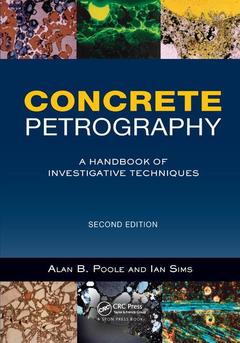Concrete Petrography (2nd Ed.) A Handbook of Investigative Techniques, Second Edition
Coordonnateurs : Poole Alan, Sims Ian

This classic reference has established the value of petrography as a powerful method for the investigation of concrete as a material. It provides an authoritative and well-illustrated review of concrete composition and textures, including the causes of defects, deterioration, and failure that can be identified using a petrological microscope. This new edition is entirely revised and updated and also greatly extended to take account of new scientific developments and significant improvements in instrumentation and to reflect current laboratory working practices, as well as to reflect new understanding of the performance of concrete and related materials.
Now in full color throughout, Concrete Petrography, Second Edition provides case study examples, with appropriate explanatory discussions and practical advice on selecting, handling and preparing specimens. It assists and guides the engineer, the trainee and the experienced petrographer in understanding the scientific evidence that is basic to petrographic analysis and so will lead to more accurate and timely diagnosis and treatment of problems in structural concrete.
This book includes:
- Contributions in specialist areas by internationally recognized experts
- Explanation of computer techniques as an aid to petrography
- Full coverage of inspection, sampling, and specimen preparation
- New sections covering recent technological development of equipment
- Guidance on observation of cement and concrete mineralogy and microfabrics
- Discussion and illustrative examples of deterioration and failure mechanisms
- New work and guidance on the determination of water/cement ratio
- New color illustrations and micrographs throughout
- Thorough updating of standards, other authoritative publications, and references
- A fully revised, extended, and updated glossary of op
1. Introduction 2. Petrographic equipment and methods 3. Sampling and specimen preparation 4. Composition of concrete 5. Appearance and textures of cementitious materials 6. Examination of deteriorated and damaged concrete 7. Precast and special concretes 8. Portland cement mortar, screeds, renders and special cements 9. Non-Portland cementitious materials, plasters and mortars. Glossary of minerals
Dr. Alan Poole began his career as a geologist before becoming a consultant specializing in the petrography of aggregates, concrete and related materials. He gained a wide experience of both the practical and research aspects of alkali-aggregate reaction in concrete working both in the UK and abroad. He is involved in specialist post-graduate training, with British and European standards committees and with technical working parties.
Dr. Ian Sims
Sydney Diamond, Purdue University, USA in the Foreword
'This authoritative book is very welcome arrival...I sincerely congratulate the authors on their tremendous effort to procuce this comprehensive invaluable text on concrete petrography...I would like to strongly recommend it to the whole cross section of professionals, researchers and academics who deal with the examination and evaluation of concrete structures, particularly those suffering from deterioration.'
Concrete Institute of Australia
'... this is one of those rare 'must read' books... this is a book that unlocks the mysteries of concrete ... one of those books that one feels one must have on the technical bookshelf because you know you will want to refer to it at almost any time... a handsome book ... if you are 'into' concrete in any way, you must try this book ...if only for a new colourful view of the 'grey old concrete'.'
The Structural Engineer
'... a good reference source...'
The Indian Concrete Journal, Sept 1998
'... a comprehensive review ... this book provides a sound description of the literature of the subject ... a valuable resource ... an excellent introduction ... a useful guide to the engineer ... clear and useful photomicrographs ... the value of petrography will be enhanced by this book.'
Chemistry and Industry, April 1999
Date de parution : 04-2020
17.8x25.4 cm
Date de parution : 07-2015
Ouvrage de 794 p.
Disponible chez l'éditeur (délai d'approvisionnement : 15 jours).
Prix indicatif 177,58 €
Ajouter au panierThèmes de Concrete Petrography :
Mots-clés :
Hydraulic Lime; Concrete Petrography; Petrographic methods; Gypsum Plaster; Petrographic equipment; BS En; Petrographic examination of concrete; Photomicrograph Courtesy; Petrographic laboratory; Ch Alk; Quantitative methods of component analysis; Plaster Of Paris; Inspection of structures; Plaster Board; Representative sample; Sorel Cement; Thin sections; Petrographic Examination; Finely ground surfaces; Sand Lime Bricks; Polished surfaces; SEM; Specimen preparation; Hydrated Lime; Composition of concrete; Lime Mortar; Air-void content; Calcium Sulphate Plasters; Air entrainment; Calcium Silicate Products; Pigments; Portland Cement; Chemical admixtures; Magnesian Limes; Fibre reinforcement; Sandlime Brick; Fiber reinforcement; Petrographic Techniques; Analysis of concrete; Calcium Silicate; Cementitious materials; Gypsum Crystals; The hardened Portland cement paste matrix; Calcium Hydroxide; High-alumina; Calcium aluminate cement concretes; Carbonation of Portland cement concretes; Interfaces within concrete; Voids in concrete; Cracking in concrete; Corrosion of steel reinforcement; Frost and freeze-thaw action; Sulphate actions; Acid attacks; Alkaline attacks; Weathering; Leaching; AAR; Damage from thermal cycling and fire; Precast concrete pipes; Block; Brick; Tile; Pavers; Reconstituted (artificial) stone; Polymer cement products; Special floor coatings; Self-compacting concrete; Lightweight aggregates; Lightweight concretes; Portland cement mortar; Screeds; Renders; Special cements; Mortar; Cementitious plasters; Jointing mortars; Bedding mortars; Special grouts; Sprayed concrete; Cementitious repair materials; Cementitious levelling compounds; Cementitious leveling compounds; Cementitious adhesive compounds; Non-Portland cementitious materials; Lime plasters; Gypsum-based wall plasters; Gypsum-based plasterboard; Concrete deterioration; Concrete deterioration mechanisms



